"Artista newyorkese simbolo degli anni Sessanta Gordon Matta Clark (1943-1978) ha focalizzato la sua ricerca sull'interazione deòò'architettura con lo spazio urbano, fino a ottenere una "fusione fra spazio, luce e politica" (Judith Russi Kirshner). Nel realizzare i suoi "non-uments" Matta Clark interviene sull'architettura di diversi edifici in disuso tagliando, segando e sezionando le loro strutture. I video sono:
Office Baroque (1977; 44 min)
Qui Gordon Matta Clark ha eseguito dei tagli all'interno di un edificio di fronte allo Steen, un luogo particolarmente frequentato dai turisti ad Anversa. Dopo la morte di Matta Clark si tentò di salvare l'opera per destinarla a un museo d'arte contemporanea, ma l'edificio fu comunque demolito poco dopo.
Conical Intersect (1975; 18 min 40 sec)
Per la Biennale di Parigi del 1975 Matta Clark ha eseguito un taglio in due case vicine al Centre Georges Pompidou nel quartiere di Les Halles. Il taglio, dalla forma di un cono attorcigliato, si ispira al film di Anthony McCall Line Describing a Cone.
Splitting-Bingo Ninth (1974; 20 min)
Splitting documenta il taglio eseguito da Gordon Matta Clark in una casa in Humphrey Street nella cittadina di Englewood, New York. Per Bingo Gordon Matta Clark ha sezionato una casa tipica di un villaggio vicino alle cascate del Niagara, dividendo la facciata in nove parti e lasciando intatta la parte centrale. Un'ora dopo la fine delle riprese la casa fu demolita e alcuni frammenti sono stati trasportati all'Artpark.
Day's End (1975; 23 min)
Nel maggio del 1975 Gordon Matta Clark ha lavorato per due mesi sulle strutture di un hangar abbandonato di New York, realizzando diverse sezioni della porta, del pavimento e del tetto.
Organizzato nell'ambito dell'attività per il Progetto Giovani del Comune di Milano"
Marc Glode, Christian Rattemeyer e Laura Ruggeri
Benjamin Léon, Ruins of the industrial landscape in Gordon Matta-Clark's work: entropy as a critical manifesto, Scholar CEAC-U. Lille, France.
The beauty of the spaces created by Gordon Matta-Clark's perforations should not overshadow the critical dimension of his work. He proceeded from the beginning to a division and a transformation of the buildings, cutting literally in the walls, the partitions or the grounds. In the context of “industrial films”,, it seems relevant to question the critical dimension which is at the heart of his artistic approach. It reveals a negative dialectic characterized by the permanent deconstruction of the places explored by Matta-Clark. How to qualify the images constructed by the artist to document an ephemeral work? Insofar as these images are an integral part of certain installations, in what ways do they document the material investigation of an abandoned industrial landscape? In the photographic series Walls (1972) which captures remains of abandoned buildings to move towards the cut of the Bronx Floors (1972-73) as well as in the Day's End (1975) projects we see the artist addressing a post- industrial place that wants to be sustainable. But in the absence of authorization, the place is closed, and the artist forced into exile. The resulting film remains the most radical testimony of “anarchitecture” concept from Matta-Clark’s perspective. By choosing his artistic freedom as a paradigm essential to his gesture, he runs up against his own system and deploys his aporia as a critical system.
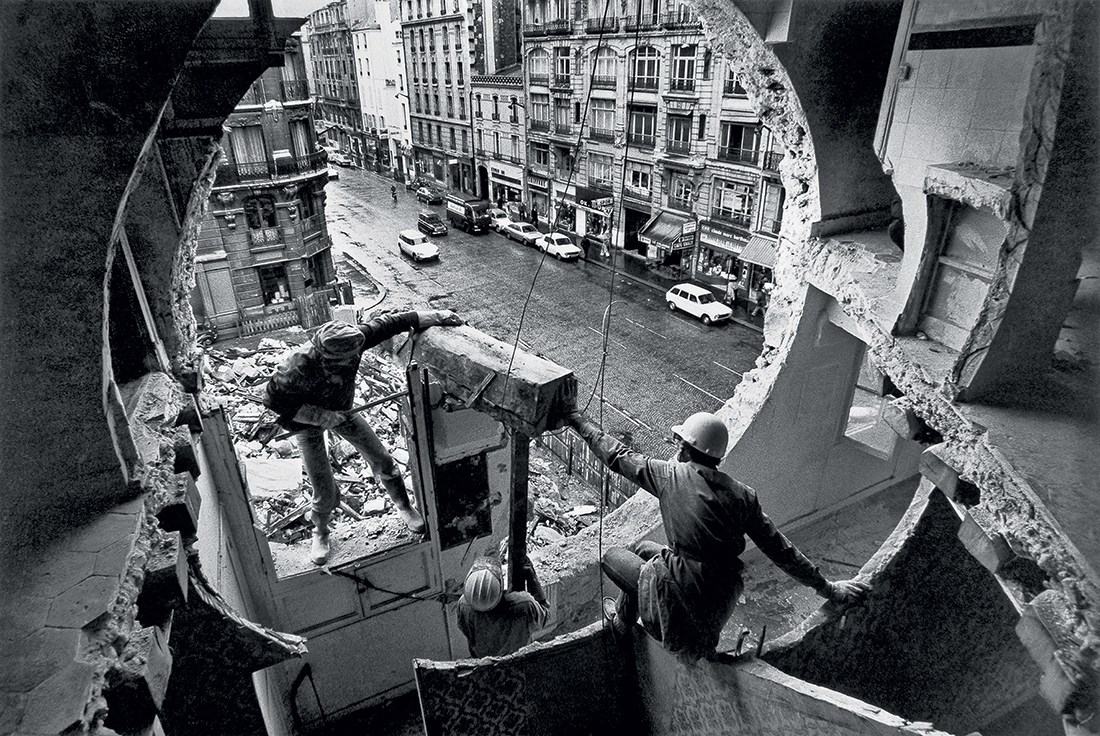
"Artista newyorkese simbolo degli anni Sessanta Gordon Matta Clark (1943-1978) ha focalizzato la sua ricerca sull'interazione deòò'architettura con lo spazio urbano, fino a ottenere una "fusione fra spazio, luce e politica" (Judith Russi Kirshner). Nel realizzare i suoi "non-uments" Matta Clark interviene sull'architettura di diversi edifici in disuso tagliando, segando e sezionando le loro strutture. I video sono:
Office Baroque (1977; 44 min)
Qui Gordon Matta Clark ha eseguito dei tagli all'interno di un edificio di fronte allo Steen, un luogo particolarmente frequentato dai turisti ad Anversa. Dopo la morte di Matta Clark si tentò di salvare l'opera per destinarla a un museo d'arte contemporanea, ma l'edificio fu comunque demolito poco dopo.
Conical Intersect (1975; 18 min 40 sec)
Per la Biennale di Parigi del 1975 Matta Clark ha eseguito un taglio in due case vicine al Centre Georges Pompidou nel quartiere di Les Halles. Il taglio, dalla forma di un cono attorcigliato, si ispira al film di Anthony McCall Line Describing a Cone.
Splitting-Bingo Ninth (1974; 20 min)
Splitting documenta il taglio eseguito da Gordon Matta Clark in una casa in Humphrey Street nella cittadina di Englewood, New York. Per Bingo Gordon Matta Clark ha sezionato una casa tipica di un villaggio vicino alle cascate del Niagara, dividendo la facciata in nove parti e lasciando intatta la parte centrale. Un'ora dopo la fine delle riprese la casa fu demolita e alcuni frammenti sono stati trasportati all'Artpark.
Day's End (1975; 23 min)
Nel maggio del 1975 Gordon Matta Clark ha lavorato per due mesi sulle strutture di un hangar abbandonato di New York, realizzando diverse sezioni della porta, del pavimento e del tetto.
Organizzato nell'ambito dell'attività per il Progetto Giovani del Comune di Milano"
Marc Glode, Christian Rattemeyer e Laura Ruggeri
Benjamin Léon, Ruins of the industrial landscape in Gordon Matta-Clark's work: entropy as a critical manifesto, Scholar CEAC-U. Lille, France.
The beauty of the spaces created by Gordon Matta-Clark's perforations should not overshadow the critical dimension of his work. He proceeded from the beginning to a division and a transformation of the buildings, cutting literally in the walls, the partitions or the grounds. In the context of “industrial films”,, it seems relevant to question the critical dimension which is at the heart of his artistic approach. It reveals a negative dialectic characterized by the permanent deconstruction of the places explored by Matta-Clark. How to qualify the images constructed by the artist to document an ephemeral work? Insofar as these images are an integral part of certain installations, in what ways do they document the material investigation of an abandoned industrial landscape? In the photographic series Walls (1972) which captures remains of abandoned buildings to move towards the cut of the Bronx Floors (1972-73) as well as in the Day's End (1975) projects we see the artist addressing a post- industrial place that wants to be sustainable. But in the absence of authorization, the place is closed, and the artist forced into exile. The resulting film remains the most radical testimony of “anarchitecture” concept from Matta-Clark’s perspective. By choosing his artistic freedom as a paradigm essential to his gesture, he runs up against his own system and deploys his aporia as a critical system.
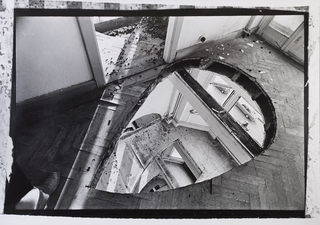
Office Baroque, 1977
Courtesy Harold Berg
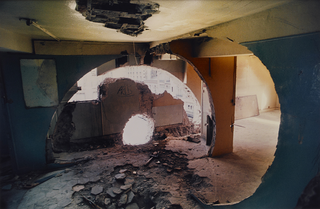
Conical Intersect, 1975
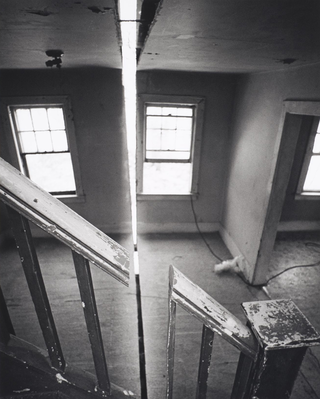
Splitting-Bingo Ninth, 1974
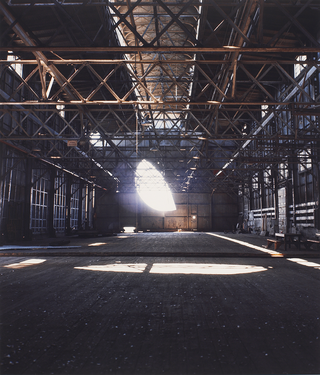
Day's End (Pier 52), 1975
Social
Contatti
viafarini@viafarini.org